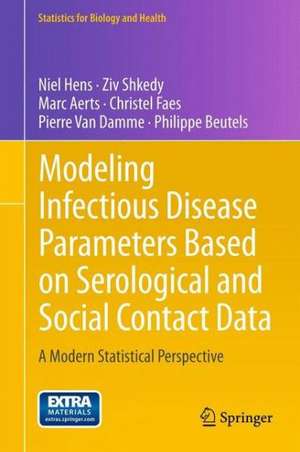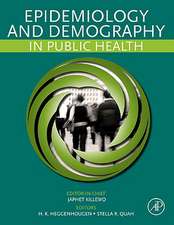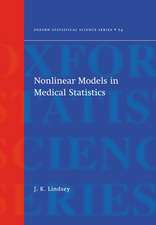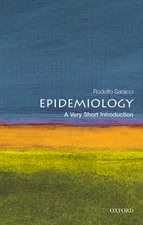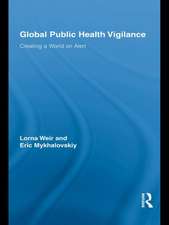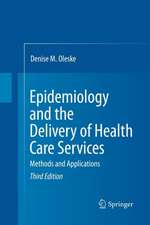Modeling Infectious Disease Parameters Based on Serological and Social Contact Data: A Modern Statistical Perspective: Statistics for Biology and Health, cartea 63
Autor Niel Hens, Ziv Shkedy, Marc Aerts, Christel Faes, Pierre Van Damme, Philippe Beutelsen Limba Engleză Paperback – 15 oct 2014
It is within this context that the Center for Statistics (CenStat, I-Biostat, Hasselt University) and the Centre for the Evaluation of Vaccination and the Centre for Health Economic Research and Modelling Infectious Diseases (CEV, CHERMID, Vaccine and Infectious Disease Institute, University of Antwerp) have collaborated over the past 15 years. This book demonstrates the past and current research activities of these institutes and can be considered to be a milestone in this collaboration.
This book is focused on the application of modern statistical methods and models to estimate infectious disease parameters. We want to provide the readers with software guidance, such as R packages, and with data, as far as they can be made publicly available.
| Toate formatele și edițiile | Preț | Express |
|---|---|---|
| Paperback (1) | 584.92 lei 6-8 săpt. | |
| Springer – 15 oct 2014 | 584.92 lei 6-8 săpt. | |
| Hardback (1) | 731.59 lei 6-8 săpt. | |
| Springer – sep 2012 | 731.59 lei 6-8 săpt. |
Din seria Statistics for Biology and Health
- 20%
 Preț: 633.24 lei
Preț: 633.24 lei - 17%
 Preț: 352.01 lei
Preț: 352.01 lei - 20%
 Preț: 776.72 lei
Preț: 776.72 lei - 20%
 Preț: 1376.35 lei
Preț: 1376.35 lei - 18%
 Preț: 1394.84 lei
Preț: 1394.84 lei - 18%
 Preț: 883.59 lei
Preț: 883.59 lei - 5%
 Preț: 843.91 lei
Preț: 843.91 lei -
 Preț: 397.16 lei
Preț: 397.16 lei - 20%
 Preț: 1002.67 lei
Preț: 1002.67 lei - 18%
 Preț: 1395.32 lei
Preț: 1395.32 lei - 5%
 Preț: 1102.10 lei
Preț: 1102.10 lei - 5%
 Preț: 874.83 lei
Preț: 874.83 lei - 15%
 Preț: 657.39 lei
Preț: 657.39 lei - 18%
 Preț: 960.93 lei
Preț: 960.93 lei - 15%
 Preț: 585.90 lei
Preț: 585.90 lei - 5%
 Preț: 852.69 lei
Preț: 852.69 lei - 18%
 Preț: 903.62 lei
Preț: 903.62 lei - 5%
 Preț: 721.40 lei
Preț: 721.40 lei - 15%
 Preț: 653.46 lei
Preț: 653.46 lei - 18%
 Preț: 2114.90 lei
Preț: 2114.90 lei - 18%
 Preț: 1108.99 lei
Preț: 1108.99 lei - 5%
 Preț: 821.39 lei
Preț: 821.39 lei - 5%
 Preț: 849.02 lei
Preț: 849.02 lei - 15%
 Preț: 653.14 lei
Preț: 653.14 lei - 18%
 Preț: 958.56 lei
Preț: 958.56 lei - 5%
 Preț: 722.69 lei
Preț: 722.69 lei - 18%
 Preț: 728.74 lei
Preț: 728.74 lei - 18%
 Preț: 943.22 lei
Preț: 943.22 lei - 5%
 Preț: 1092.43 lei
Preț: 1092.43 lei - 15%
 Preț: 594.21 lei
Preț: 594.21 lei - 5%
 Preț: 377.87 lei
Preț: 377.87 lei - 18%
 Preț: 1124.60 lei
Preț: 1124.60 lei - 18%
 Preț: 1220.12 lei
Preț: 1220.12 lei - 15%
 Preț: 632.98 lei
Preț: 632.98 lei - 18%
 Preț: 1394.84 lei
Preț: 1394.84 lei -
 Preț: 389.11 lei
Preț: 389.11 lei - 18%
 Preț: 959.98 lei
Preț: 959.98 lei
Preț: 584.92 lei
Preț vechi: 688.15 lei
-15% Nou
Puncte Express: 877
Preț estimativ în valută:
111.92€ • 116.87$ • 92.42£
111.92€ • 116.87$ • 92.42£
Carte tipărită la comandă
Livrare economică 15-29 aprilie
Preluare comenzi: 021 569.72.76
Specificații
ISBN-13: 9781489987969
ISBN-10: 1489987967
Pagini: 316
Ilustrații: XVI, 300 p.
Dimensiuni: 155 x 235 x 17 mm
Greutate: 0.45 kg
Ediția:2012
Editura: Springer
Colecția Springer
Seria Statistics for Biology and Health
Locul publicării:New York, NY, United States
ISBN-10: 1489987967
Pagini: 316
Ilustrații: XVI, 300 p.
Dimensiuni: 155 x 235 x 17 mm
Greutate: 0.45 kg
Ediția:2012
Editura: Springer
Colecția Springer
Seria Statistics for Biology and Health
Locul publicării:New York, NY, United States
Public țintă
ResearchCuprins
Mathematical models for infectious diesease.- The static model.- The dynamic model.- The stochastic model.- Implementation of models in MATLAB.- Data sources for modelling infectious diseases.- Estimation from serological data.- Parametric models for teh prevalence and the force of infection.- Non-parametric approaches to model the prevalence and force of infection.- Semi-parametric approaches to model the prevalence and force of infection.- A Bayesian approach.- Modelling the prevalence and the force of infection direction from antibody levels.- Modelling multivariate serological data.- Estimation from other data sources.- Estimating mixing patterns and Ro in a heterogenous population.- Modelling in a homogeneous population.- Modelling in a heterogeneous population.- Modelling AIDS outbreak data.- Modelling hepatitis C among injection drug users.- Modelling dengue.- Modelling bovine herpes virus in cattle.
Textul de pe ultima copertă
Mathematical epidemiology of infectious diseases usually involves describing the flow of individuals between mutually exclusive infection states. One of the key parameters describing the transition from the susceptible to the infected class is the hazard of infection, often referred to as the force of infection. The force of infection reflects the degree of contact with potential for transmission between infected and susceptible individuals. The mathematical relation between the force of infection and effective contact patterns is generally assumed to be subjected to the mass action principle, which yields the necessary information to estimate the basic reproduction number, another key parameter in infectious disease epidemiology.
It is within this context that the Center for Statistics (CenStat, I-Biostat, Hasselt University) and the Centre for the Evaluation of Vaccination and the Centre for Health Economic Research and Modelling Infectious Diseases (CEV, CHERMID, Vaccine and Infectious Disease Institute, University of Antwerp) have collaborated over the past 15 years. This book demonstrates the past and current research activities of these institutes and can be considered to be a milestone in this collaboration. This book is focused on the application of modern statistical methods and models to estimate infectious disease parameters. We want to provide the readers with software guidance, such as R packages, and with data, as far as they can be made publicly available.
It is within this context that the Center for Statistics (CenStat, I-Biostat, Hasselt University) and the Centre for the Evaluation of Vaccination and the Centre for Health Economic Research and Modelling Infectious Diseases (CEV, CHERMID, Vaccine and Infectious Disease Institute, University of Antwerp) have collaborated over the past 15 years. This book demonstrates the past and current research activities of these institutes and can be considered to be a milestone in this collaboration. This book is focused on the application of modern statistical methods and models to estimate infectious disease parameters. We want to provide the readers with software guidance, such as R packages, and with data, as far as they can be made publicly available.
Caracteristici
Demonstrates the application of modern statistical methods and models to estimate infectious disease parameters Provides the reader with software guidance and data Uses valuable case studies Includes supplementary material: sn.pub/extras
